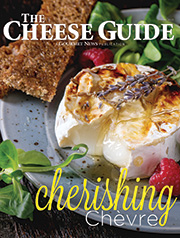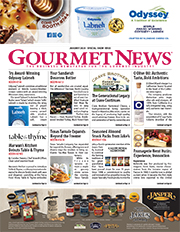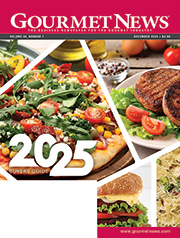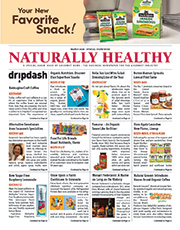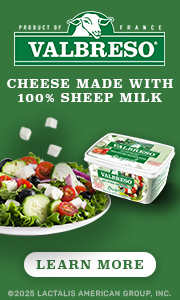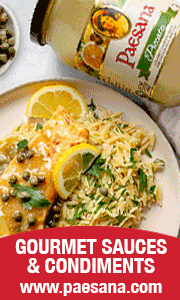Sprinkles Promotes Murakami to Chief Operating Officer
 Sprinkles Bakeries and Picnik Restaurants has promoted Justin Murakami to chief operating officer, recognizing his exemplary contributions and leadership in steering operational growth and innovation. His promotion signals a pivotal phase in executing Sprinkles’ growth strategies domestically and internationally.
Sprinkles Bakeries and Picnik Restaurants has promoted Justin Murakami to chief operating officer, recognizing his exemplary contributions and leadership in steering operational growth and innovation. His promotion signals a pivotal phase in executing Sprinkles’ growth strategies domestically and internationally.
Dan Mesches, president and CEO, lauded Justin’s appointment, affirming, “Justin’s strategic foresight and operational expertise have been instrumental in our company’s success, especially in expanding Sprinkles’ global footprint and Picnik’s domestic expansion. We’re confident that under Justin’s leadership, we’ll continue to exceed expectations, scale efficiently and solidify our position as industry leaders.”
Since joining Sprinkles in 2017, Justin swiftly became an integral part of the company’s evolution. His instrumental role in developing and implementing foundational systems and processes laid the groundwork in expanding the brand’s physical footprint with both company-owned and franchised locations, domestically and internationally.
Notably, under his stewardship, Justin took the brand’s iconic cupcake ATMs beyond their brick and mortar locales and launched the non-traditional Cupcake ATM business. With over 50 ATMs and counting, Sprinkles ATMs can be found in airports, malls and lifestyle centers across the country. Justin was also instrumental in the successful launch of Sprinkles’ National Shipping Program, creating another channel for significant growth.
With an impressive career spanning 25 years in the hospitality sector, Justin has navigated through the ranks starting as a host, then becoming a GM at the Cheesecake Factory to an Area Director overseeing multiple brands with Lettuce Entertain You and Hopdoddy Burger Bar. His vast experience has honed his abilities and insights, propelling him to craft and fortify infrastructures conducive to sustained business growth.
As COO, Murakami will lead operations, training, supply chain, culinary, franchise operations and new bakery and restaurant openings. His responsibilities include partnering with cross-functional departments, identifying opportunities and gaps, formulating and implementing robust processes and systems to ensure scalability and ease for the team.
Murakami expressed his enthusiasm about the promotion, stating, “Assuming the role of chief operating officer at Sprinkles and Picnik is a tremendous honor. I am devoted to leveraging our team’s strengths, harnessing operational excellence, and charting a growth trajectory that maintains our commitment to exceptional guest experiences. I am excited about the opportunity to not only drive innovation and sustainable expansion for our business, but to continue nurturing and developing the people I work with every day.”
For more news of interest to the bakery industry, subscribe to Gourmet News.
Raybern’s Rebrands Packaging, Revamping Deli Sandwich Line
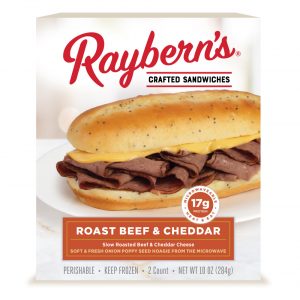 Raybern’s, a brand known for offering authentic deli-style Philly Cheesesteak sandwiches, kicks off a rebrand not only in package design, but in terms of quality, quantity and variety of sandwich ingredients. Beginning Q1, 2024, Raybern’s will introduce a revamp of its entire line, offering unique flavors and formats that are designed and created to thrill discerning sandwich lovers everywhere.
Raybern’s, a brand known for offering authentic deli-style Philly Cheesesteak sandwiches, kicks off a rebrand not only in package design, but in terms of quality, quantity and variety of sandwich ingredients. Beginning Q1, 2024, Raybern’s will introduce a revamp of its entire line, offering unique flavors and formats that are designed and created to thrill discerning sandwich lovers everywhere.
Five delicious Raybern’s varieties will be available in 2-ct packs to consumers at an SRP of $5.79, and sold in freezer cases everywhere.
Raybern’s introduces new and innovative recipes to their full line of mouthwateringly savory sandwiches. Notably, the Roast Beef & Cheddar sandwich is now complemented with a soft, poppy seed roll. In addition, Raybern’s is relaunching their Ham & Cheese sandwich, enhanced by a sweet deli roll.
The rest of the line has been upgraded with delectable meats, cheeses and sauces, including the Philly Cheesesteak, Chicken Bacon Ranch and Barbecue Pulled Pork. In this complete brand overhaul, Raybern’s is ensuring that frozen food consumers don’t have to compromise when they walk down the freezer aisle.
“Our new sandwich line up is a totally delicious innovation on sandwiches of the past,” shares Doug Hall, director of marketing at Raybern’s. “We have the bakery-soft bun covered, but we’ve completely amped up the meats, cheeses and sauces on our favorite frozen deli-style sandwiches! My personal favorite is the Roast Beef & Cheddar now on a fresh poppy seed roll.”
When it comes to sandwiches, Raybern’s has proven to be a brand that knows how to bring amazing flavor from the freezer to the microwave. Over 30 years ago, the founders Ray and Bernie envisioned sharing their love of New York-style deli sandwiches with the world. It took years to fully develop the Raybern’s bread recipe that cooks up “Bakery Soft” right from the microwave – as well as their signature Philly Cheesesteak recipe.
Today, Raybern’s is proud to make millions of sandwiches each year, including the best-selling Philly Cheesesteak in America, according to 2023 Nielsen Scan Data. Now, the brand introduces bigger and better sandwiches to continue giving consumers what they crave.
Raybern’s believes that the New York-style deli sandwich reigns supreme. Since 1978, they have been crafting incredibly delicious sandwiches with bakery-soft bread, slow-roasted meats and chef-created sauces. Now, consumers can enjoy authentic deli goodness at home or while on-the-go. It is Raybern’s mission to share its love of great sandwiches with as many people as possible and ensure that sandwich lovers don’t need to compromise in the freezer aisle.
For more new products in the specialty food industry, subscribe to Gourmet News.
Yam or Sweetpotato? Sweetpotato or Sweet Potato? Answers Here
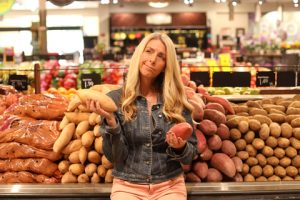 It happens every Thanksgiving. You head to the grocery store to shop for the big day. Of course, you’ll need to buy yams for the family’s favorite casserole. But when you get to the produce department, the display sign says “sweetpotato.” Or perhaps some are labeled as “yams” and others are “sweetpotatoes.” Which should you buy? And what’s the difference between a sweetpotato and a yam anyway?
It happens every Thanksgiving. You head to the grocery store to shop for the big day. Of course, you’ll need to buy yams for the family’s favorite casserole. But when you get to the produce department, the display sign says “sweetpotato.” Or perhaps some are labeled as “yams” and others are “sweetpotatoes.” Which should you buy? And what’s the difference between a sweetpotato and a yam anyway?
This Thanksgiving, California sweetpotato farmers are on a mission to end this confusion once and for all. Their message is really very simple: Yam = Sweetpotato
“Sweetpotatoes come in all kinds of colors – red, orange, white, and, even purple. You may see them labeled as yams in the grocery store, but they’re actually sweetpotatoes,” explains Sarah Alvernaz, who farms sweetpotatoes in the heart of California’s sweetpotato growing region.
Alvernaz and other California growers who make up the California Sweetpotato Council are working to educate consumers and put an end to all the confusion about sweetpotatoes versus yams, particularly for younger consumers who may not be interested in eating yams but have heard that sweetpotatoes are a superfood.
“True yams are very different from sweetpotatoes and are a starchy, tuberous vegetable mostly grown in Africa,” explains Alvernaz. “You are unlikely to find true yams at a U.S. supermarket, despite what you might see on display signs.”
Unlike yams, sweetpotatoes are native to the Americas. The United States produces approximately 1.7 million tons of sweetpotatoes each year. California is the second largest producing state for sweetpotatoes because the warm dry climate and sandy soils of California’s Central Valley provide the optimum growing environment for quality roots. Some 90 percent of California’s sweetpotatoes are grown within a 20-mile radius of the small town of Livingston and the remaining 10 percent are grown near Bakersfield.
Alvernaz also explains that it’s common to see some sweetpotatoes at your grocery store labeled by varietal names such as Covington, Garnet or Jewell. But growers actually produce dozens of different varieties.
“We’re encouraging retailers to label sweetpotatoes according to color,” notes Alvernaz. “Most varieties we grow can be accurately categorized as either red, orange, white or purple sweetpotatoes. All four types have similar cooking times and can be used pretty much interchangeably in recipes.”
“We just want people to know that sweetpotato is a modern, more accurate term than yam,” says Alvernaz. “Even if they’re labeled as yams in the store, they are sweetpotatoes! Whether they’re red, orange, white or purple – all can be used in any recipe that calls for yams. Sweetpotatoes are a versatile, delicious superfood available every day of the year.”
To help support this message, the California Sweetpotato Council is working with retailers to correctly label sweetpotatoes in their stores. Shoppers can find simplified, updated information about sweetpotatoes here.
“Rest assured the Thanksgiving yam dish that’s been in your family for generations has always been made with sweetpotatoes,” says Alvernaz. “Probably with red or orange varieties but go ahead and buy whatever color you find in your store. And don’t forget that sweetpotatoes can be used in a variety of recipes not just for the holidays.”
Alvernaz adds that sweetpotatoes are, in fact, a superfood with each containing over 80 nutrients. They’re high in vitamin B6, vitamin A, carotene, and potassium, they’re rich in antioxidant vitamins C and E and are a great source of manganese and dietary fiber.
More information about sweetpotato nutrition, cooking facts and delicious recipes can be found at the California Sweetpotato Council website here.
For the record, the council says it’s sweetpotato, not sweet potato: On this one we admit there’s not a lot of agreement. But we believe that “sweetpotato” is correct because our product is not, in fact, a sweet potato. It’s not a potato at all, but botanically an entirely different vegetable, gifted with a totally different set of better-for-you nutrients, amazing taste, and incredible versatility. So sweetpotatoes—one word—is not only grammatically correct, but it helps make the distinction.
For more news of interest to the specialty food industry, subscribe to Gourmet News.
